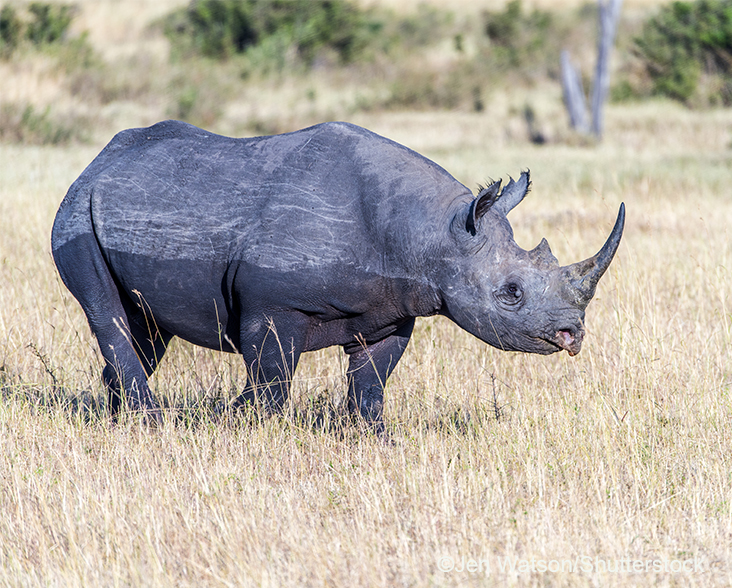Species Data
Class: Mammalia
Order: Perissodactyla
Family: Rhinocerotidae
Scientific Name: Diceros bicornis michaeli
IUCN Red List status: Critically Endangered
Description
The Eastern Black Rhino is one of four extant subspecies of Black Rhino (Diceros bicornis).
They are the smaller of the two African rhino species, the other being White Rhino (Ceratotherium simum), reaching 1.6 metres tall at the shoulder, with females weighing up to 900 kg and bulls up to 1,350 kg.
The skin of both Black and White Rhinos, up to 5 cm thick, is actually the same dark brown to grey colour.
The Black Rhino is best distinguished from the White Rhino by its pointed rather than square upper lip, less pronounced hump on the back of the neck and a smaller head. Both species have two horns that grow continually from the base throughout their life at up to three inches a year. Males tend to have thicker horns and females longer, thinner horns. The anterior horn is longer than the posterior horn, averaging at around 50 cm in length, but known to reach five feet long!
Like all rhino species, Black Rhinos have three toes. Black Rhinos live up to 35 years in the wild.
Behaviour
This species is mainly solitary, although it was recently discovered that adult males can be semi-social at water holes. Adult males have a territory of 3.9-4.7 km, with older animals usually dominant and younger males subordinate. Adult females are most often in the company of their latest calf.
Black Rhinos have extremely poor eyesight and communicate primarily through scent-marking, such as leaving dung piles known as ‘middens’ throughout their territory, rubbing a scent gland on their head against trees or rocks, or urine spraying, which is how females let bulls know when they are in oestrus.
Females reach sexual maturity at 3.5-4 years old. The gestation period is 15-17 months and females give birth alone. Calves weigh 30-45 kg at birth and are usually able to stand within a few hours. They are weaned after two months but will stay with their mother for 2-4 years before the female is ready to calve again.
Black Rhinos forage mainly during the night or at dawn and dusk. They are herbivores, using their pointed prehensile upper lip to browse on leaves, fruit, and twigs taken from trees and bushes, rather than grazing on grasses like their big-headed, square-lipped White Rhino relatives do.
During the day they shelter from the sun in the shade, or wallow and roll around at a water hole, coating their skin with mud that acts as both an insect repellent and sunblock.


Habitat
The Eastern Black Rhino inhabits a range of habitats that have shrubs, trees, and herbs, along with water sources and mineral licks nearby, including savanna, shrubland, woodland, dense forest, and wetlands.
This subspecies was formerly found in Eritrea, Ethiopia, Somalia, South Sudan, Sudan, and Uganda, but is now found naturally only in Kenya and Tanzania. There is an introduced population outside their natural range in South Africa, from which reintroductions have been made to Uganda. There have also been introductions in Chad.
Threats and Conservation
In 1960 there was an estimated 100,000 Black Rhino (of all subspecies) in Africa, but due to poaching the population fell to around 65,000 by 1970. The number of Eastern Black Rhino, the rarest of the three remaining subspecies, also declined dramatically, from 14,231 in 1973 to less than 400 in the late 1980s, before increasing to 1,002 in 2017, a total made up of 745 in Kenya, 155 in Tanzania, 19 in Uganda, and a further 83 introduced animals in South Africa. The decline was initially caused by culling to make way for agriculture and made worse by poaching inside and outside protected areas.
Poaching for the illegal international rhino horn trade, banned since 1977 under CITES, remains the biggest threat to the Black Rhino. Most rhino horn ends up in Asia, especially China for use in traditional Chinese medicine, and Vietnam where rhino horn is regarded by some wealthy urban Vietnamese as a symbol of high social status, often carved into ornaments such as bowls and bangles and frequently gifted to family members, friends, and business colleagues. Although the population has increased, so too has poaching. Therefore, both the Black Rhino species and the Eastern Black Rhino subspecies remain categorised as Critically Endangered on the IUCN Red List.
Between 91-100% of the Eastern Black Rhino population exists in protected areas. To restore the population, animals must be adequately protected against poaching, the population size accurately monitored to assess how they are doing, and populations managed to ensure that they do not adversely affect their habitat. Funding and training field rangers from local communities is also essential.
